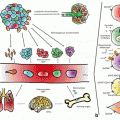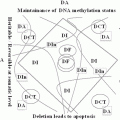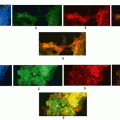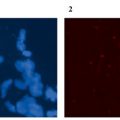Fig. 16.1
Schematic diagrams of Bioresonance therapy
Bioresonance therapy (BRT) is based upon the knowledge that the entire body is held together at the subatomic level by waves and photons.
Every material is made up of atoms, whether it is a virus, bacteria or a human being. Atoms themselves are made up of subatomic particles—protons, neutrons and electrons. All subatomic particles share a fundamental property: They have “intrinsic angular momentum,” or spin. This means they rotate in one direction, just like a planet. Physicists discovered that subatomic particles behave like energy and radiate energy into their surroundings in specific patterns, called waves.
Subatomic particles have dual characteristics as both particles and wave forms. Subatomic particles vibrate at different rates or frequencies based in part on changes in temperature and thermodynamics. In their waveform state, quantum particles emit a frequency vibration that extends indefinitely. In this state, subatomic particles are present in all space in what is known as superposition. In the superposition state, they are also in contact with every other subatomic particle in the universe. This interconnection provides a huge amount of information transfer between all of the building blocks of our universe, including our own body. Each bacterium, each virus, organic substance has its own specific resonant frequency. (Cottingham and Greenwood 2007).
One kind of biological resonance is sunlight. If light, as the electro-magnetic oscillation of a defined frequency touches skin, it triggers regulatory reactions, such as pigmentation or the formation of vitamin D. Light’s effect on the circadian rhythms of all or most animals has been well documented. Clearly, that huge number of other frequencies encountered during life also has some kind of effect on the organism. (Baehr et al. 1999; Holick 2004).
Researchers have been able to study the distinct wave patterns of normally-functioning body systems and organs as well as the oscillations of allergens, viruses, bacteria, and toxins.
Dr. Franz Morell is the father of bioresonance therapy. At the beginning of 1953 Dr. Morell was a member of the group investigating electro-acupuncture testing under the direction of Dr. Voll. Voll discovered that by making measurements of skin resistance at acupuncture points, diagnoses about the condition of the meridian energies could be made. He also revealed that this technique could be used to test allergic reactions to allergens. This is a way of testing the effects of harmful substances, allergens as well as drugs on the body. This test and therapy method is known as electro-acupuncture .
Morell developed electro-acupuncture further by discovering that the reversal of polarity in a body or material oscillations using the appropriate type of device led to “obliteration phenomena” in the body. This resulted, for example, in a form of allergy therapy which was practiced as “allergy obliteration”. This rotation of the information on an allergy or a body’s own oscillation is known as inversion (Herrmanna and Galleb 2011; Chen et al. 2010).
Biophotons were discovered in 1992, when the Russian embryologist Alexander G.Gurwitsch (1874–1954) performed an experiment with onion roots. He found that some effect from the dividing cells at the tip of one root stimulated the division of cells in the other root and called it “mitogenetic radiation ” (Beloussov 1997).
Gurwitsch was persuaded that this radiation is an expression of morphogenetic fields within the organism that structure and organize the life processes in the cell and the organism. In developmental biology, a morphogenetic field is a group of cells able to respond to discrete, localized biochemical signals leading to the development of specific morphological structures or organs. Later, many other researchers, included Popp and his colleagues all over the world have not only demonstrated the existence and ubiquity of biophoton emission beyond any reasonable doubt, but also established its properties, developed and tested a number of hypotheses about its possible biological functions, done a lot of theoretical work towards explanation of biophoton theory and started to develop a number of practical applications for the use of biophoton measurements of microorganisms, plants, animals and humans.
Popp noted that a healthy cell stores light the longest. A healthy cell radiates coherent light, while a diseased cell radiates chaotic light. A large increase in biophoton flux during mitosis arises from the generation of a large amount of information, while an increase at the time of death is due to the usual thermodynamic cooling that occurs at the sudden destruction of a large amount of information. (Cohen and Popp 1997; Popp et al. 2002).
A biophoton is a photon of non-thermal origin in the visible and ultraviolet spectrum emitted from a biological system. The term biophoton used in this narrow sense should not be confused with the broader field of biophotonics, which studies the general interaction of light with biological systems.
Biochemical reaction via biotransformation phases and oxidative stress by reactive oxygen and nitrogen species and/or catalysis by enzymes is a common event in the biomolecular microenvironment. Such reactions can lead to the formation of triplet excited species, which release photons upon returning to a lower energy level in a process analogous to phosphorescence (Giuseppe and Waldemar 1995).
The study done by Ankush Prasad and Pave Pospısil revealed that the oxidation of linoleic acid by hydroxyl radical and intrinsic lipoxygenase results in the ultra-weak photon emission (Prasad and Pospısil 2011).
Actually, the human body emits biophotons, also known as ultra-weak photon emissions (UPE), with a visibility 1000 times lower than the sensitivity of our naked eye. While not visible to us, these particles of light or waves are part of the visible electromagnetic spectrum (380–780 nm) and are detectable via sophisticated modern instrumentation (Schwabl and Klima 2005; Niggli et al. 2005; Artem’ey et al. 1967).
Seemingly biophotons are used by the cells of many living organisms to communicate, that facilitates energy/information transfer which is several orders of magnitude faster than chemical diffusion. According to Yan Sun and his collogues, “Cell to cell communication by biophotons have been demonstrated in plants, bacteria, animals, neutrophil granulocytes and kidney cells (Sun et al. 2010).
Researchers were able to demonstrate different spectral light stimulation at one end of the spinal sensory or motor nerve roots resulted in a significant increase in the biophotonic activity at the other end”. Researchers interpreted their finding to suggest that light stimulation can generate biophotons that conduct along the neural fibers, probably as neural communication signals. The change of biophotonic activity is noticeable under physiological and pathological conditions. For example, mechanical, thermal and chemical stresses, mitochondrial respiration, the cell cycle and cancer growth lead to these biophotonic activities (Sun et al. 2010; Tilbury 1992; Slawinski et al. 1992; Niggli 1993; Amano et al. 1995; Kataoka et al. 2001; Nakano 1989; Yoon 2005) .
While Reactive oxygen species (ROS) and radical theory of biophoton origin is relatively simple and easily understandable due to more or less common biochemical approach, DNA theory of biophoton origin is much more complex (Fig. 16.2).
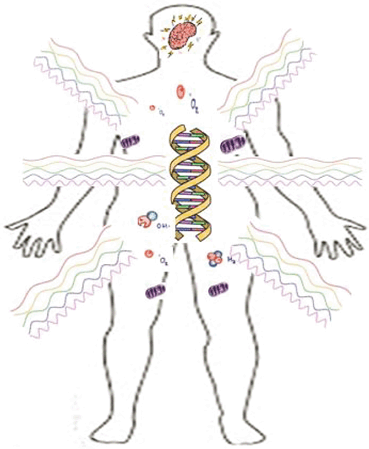

Fig. 16.2
Sources of electromagnetic waves. Biophotons and electromagnetic waves are emitted by the human body and can be released through oxidative reaction, DNA configuration changing, mental intention, and may modulate fundamental processes within cell-to-cell communication and DNA
Popp discovered that photons provided the vehicle for which information was transmitted. They transmit information within a cell and between cells. Popp demonstrated that DNA of living cells is the major source of biophoton storages and emissions. In this theory the DNA helix in cell nucleus is considered to be quantum electrodynamic cavity that is constantly excited by metabolic activity of cell.
According to the biophoton theory developed on the base of these discoveries, the biophoton light is stored in the cells of organism-more precisely, in the DNA molecules of their nuclei—and a dynamic web of light constantly released and absorbed by the DNA may connect cell organelles, cells, tissues and organs within the body, and serve as the organisms main communication network and as the principal regulating instance for all life process. Popp believed that cancer cells can be detected by the biophoton emission of the cancerous cells and these cells can potentially be destroyed by biophotons. Popp discovered cells of an organism communicate by chemical-massager molecule or by light (Gisel 2009; Popp et al. 1984).
A Bonghan duct, also known as a primo vessel, was identified by Bonghan Kim in the 1960s, is a thread-like structure found on the surface of mammalian organs, blood vessels, lymphatic vessels and under the skin (Stefanov and Kim 2012). Bonghan ducts renamed as Primo vascular system (PVS) by the Seoul National University (SNU) research group in 2002 (Soh et al. 2011). More recently, the vessels were isolated and observed using confocal laser scanning microscopy (CLSM) and transmission electron microscopy (TEM) , showing they were movable on the endocardium of the bovine atrium and ventricle (Lee and Bae 2011). The liquid carried within the PVS consists of various microparticles, such as DNA, proteins, and hormones. It is proposed that the PVS is a circulatory system in which microparticles, such as extracellular DNA (eDNA) and microvesicles, are floating and interacting (Lee and Lee 2013).
Experiment conducted by Bonghan Kim and Sang-Hyun Park showed that PVS has electrical signals similar to those from smooth-muscle-like cells.
In 1791 Galvan observed that injured tissue would generate electrical currents which was steady state or DC (direct current) in character (Piccolino 1998). Burr (1972) established, with the aid of voltmeters and electrodes, that every living organism possesses what he has termed as L-field (life-field)—a voltage difference between two points on, or close to, the surface of the living form. A complete listing of Burr’s articles can be found in the Yale Journal of Biology and Medicine (Burr 1936).
Emission of photons in the visible range by animal cells and tissues has been described for a variety of organs and by many researchers. With the use of photomultiplier tubes, emissions of photons in the visible range have been already detected from the liver, heart, lung, nerves, skin and muscles (Kim et al. 2003; Cadenas 1980; Blokha 1968; Cohen and Popp 1997).
Modern research has confirmed the observations of Burr. Not only does every event in the body, either normal or pathological, produce electrical changes, it also produces alterations of the magnetic fields in the spaces around the body. This can guide to possible diagnostic applications in connection with bioresonance.
16.3 Epigenetics and Bioresonance
Epigenetic changes are continual changes in gene expression that do not involve any change in DNA sequence. They may last for varying times-within a long-lived cell, from cell to cell during development, or sometimes from parents to offspring. Arthur Riggs and colleagues defined Epigenetics as “the study of mitotically and/or meiotically heritable changes in gene function that cannot be explained by changes in DNA sequence”. (Russo et al. 1996). In parallel to the term “genome” that defines the complete set of genetic information contained in the DNA of an organism, “epigenome” generally refers to the complete set of characteristics of epigenetic pathways in an organism. Researchers have identified four types of epigenetic pathways: DNA methylation, histone modification, nucleosome remodeling, and non-coding RNA-mediated pathways.
These epigenetic pathways intertwine with each other to regulate expression of genes and it is likely that other pathways beyond these four known ones be discovered in the future. (Van Vliet et al. 2007). Normal and abnormal physiological responses to environmental stimuli may be mediated by epigenetic mechanisms. Epigenetic states are reversible and can be modified by environmental factors.
The three-dimensional conformation of chromosomes in the nucleus is important for many cellular processes, including the regulation of gene expression, DNA replication, and chromatin structure (Cremer and Cremer 2001).
Oscillation is the repetitive variation, typically in time, of a central value (often a point of equilibrium) or between two or more different states. Familiar examples include a swinging pendulum and AC power. Oscillations occur not only in physical systems but also in biological systems, from human society to the brain Oscillations occur when a system is disturbed from a position of stable equilibrium. This displacement from equilibrium changes periodically over time. Thus, Oscillations are said to be periodic, and display periodic motions in human and animal cells and organs that connect with neighboring organs and environment. The harmonic oscillator has a single degree of freedom. More complicated systems have more degrees of freedom, for example two masses and three springs (each mass being attached to fixed points and to each other). In such cases, the behavior of each variable influences of the others. This leads to a coupling of the oscillations of the individual degrees of freedom. For example, two pendulum clocks (of identical frequency) mounted on a common wall will tend to synchronize. Coupled oscillators are oscillators connected in a way that energy can be transferred between them. As the number of degrees of freedom becomes arbitrarily large, a system approaches continuity; examples include a string or the surface of a body of water. Such systems have an infinite number of normal modes and their oscillations occur in the form of waves that can characteristically propagate. In the eukaryotic nucleus, DNA is packed into a periodic nucleoprotein complex, known as chromatin. The nuclear chromatin organized as clustered and has electric oscillation capacity. The coupling strengths of chromatin regions are determined by physical interactions among chromatin-associated proteins, the electromagnetic fields around the oscillating chromosomal regions, and the hydrogen and other bonds linking different chromatin regions within the same chromosome. The natural frequency of an oscillating chromatin region is determined by the physical properties of DNA-protein complexes in that region, which can be changed by its epigenetic state and the protein factors associated with it (Zhao and Zhan 2012). On the other hand, experiments confirmed that Biophotons can be absorbed by natural chromophores such as porphyrin rings, flavi1nic, pyridinic rings, lipid chromophores and caromatic amino acids, etc. (Gao and Xing 2009; Mazhul’ and Shcherbin 1999).
We now know that the photon can exchange between the bio-systems. It also was shown that the excision exchange supposedly constitutes the effective system of signaling and regulation of the bio-system development. It seems that such signaling to the large extent regulates the homogeneity of bio-system growth, preventing the large fluctuations of its global form and defines its morphogenesis.
Experimental results show that under the different stress conditions the photon rates from bio-system can rise in short time significantly, probably, as the consequence of intensive internal signaling (Mayburov 2009).
Experiment conducted by Peter P. Gariaev and co-workers in Moscow confirmed that the chromosomes and DNA produce “laser radiations”. They suggested (1) that there are genetic “texts”, similar to natural context-dependent texts in human language; (2) that the chromosome apparatus acts simultaneously both as a sender and receiver of these genetic texts, respectively decoding and encoding them; (3) the chromosome continuum acts like a dynamical holographic gate, which displays weak laser light and electro-acoustic fields. The distribution of the character frequency in genetic texts is fractal, so the nucleotides of DNA molecules are able to form holographic pre-images of biostructures (Gariaev 2001). He supposed that genetic information, except for the coding form, exists in a quantum (wave) form. This model enables a fundamentally different way to cure people who suffered from cancer, viral diseases, bacterial infections, and degenerative processes in organs and tissues. The disruption of the electromagnetic energy system can disrupt DNA transcription; suppress T-cell and NK-cell activity all leading to chronic degenerative diseases, depression, and other problems. Electrons absorb and emit photons, which is why the DNA electrons are storage houses for biophotons. It is believed that the specific vibratory rate of each biophoton is what activates specific gene sequencing via resonance. It has been documented that DNA repair can be activated by using a frequency of 528 hz. At that precise frequency the clustered water molecules that surround the DNA structure form a perfect six-sided hexagon.
16.4 Conclusion
All cells have small electrically powered pumps inside of them. Healthy cells, according to Nobel Prize winner Otto Warburg, have cell voltages of 70–90 millivolts. Bioelectric signals are generated by specific ion channels and pumps within cell membranes. The segregation of charges achieved by ion fluxes through such transporter proteins gives rise to a trans-membrane voltage potential (McCaig and Rajnicek 2005).
Meanwhile, all living cells of plants, animals and humans constantly emit ultra-weak biophotons in the optical range of the spectrum, which is associated with their physiological states. The intensity of biophotons is in direct correlation with, organ energy metabolism, organ activity, organ blood flow, organ health status and oxidative processes (Kobayashi et al. 1999b).
The biophoton light is stored in the cells, almost exclusively inside the DNA molecules, managing processes, alike a dynamic web of light, which is constantly released and absorbed. Frohlich argued that as organisms are made up of strong bipolar molecules packed rather densely together, electric and elastic forces can constantly interact. Cells and organisms display their own rhythms of activity that are partly internally regulated, but they also respond to external energy (Fröhlich 1980).
Bio-mechanical resonance is created when a small periodic stimulus of the same natural vibration period of a cell, tissue, or even a molecule, is used to produce a large amplitude vibration of the cell, tissue, or molecule.
Biophysicists view the body as an interconnected bio-energetic organism. The key to understanding bioresonance lies in understanding the fact that all vital processes in the organism are influenced and controlled by electromagnetic oscillations. These electromagnetic oscillations are super-ordinate to the biochemical processes and control them. Cell associations and organs oscillate in particular frequency ranges. Thus, an oscillation spectrum arises in the organism.
Stay updated, free articles. Join our Telegram channel

Full access? Get Clinical Tree



